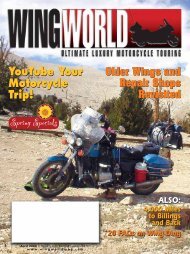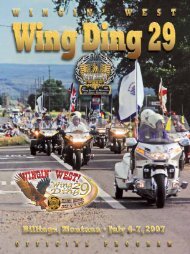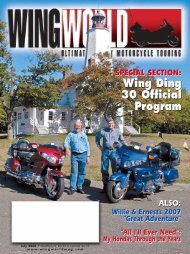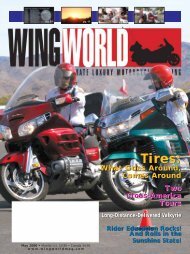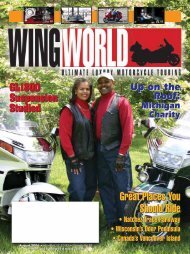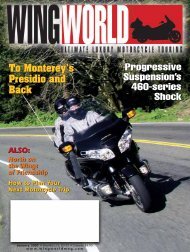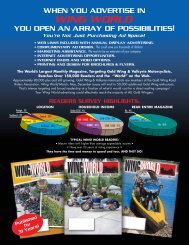The early days <strong>of</strong> J&M’straveling road show, withinven<strong>to</strong>ry in <strong>to</strong>w.Melinda staffing the J&Mbooth at <strong>Wing</strong> Ding 1.An early Rider magazine ad for J&M.first products, they joined the Tucson Chapter(GWRRA’s very first Chapter) <strong>of</strong> a group <strong>of</strong>riders dedicated <strong>to</strong> the 4-cylinder Gold <strong>Wing</strong>machines from Honda—the recently formedGold <strong>Wing</strong> Road Riders Association. Theyhave been Member number 301 ever since.Note the early ad from Rider magazine.This helmet was set up only for listening—CBand intercom capability were optional backthen. But when combination radios (AM/FM/CB) became available along with the CycleSound radio housing <strong>to</strong> fit the Windjammerfairing, helmet headsets capable <strong>of</strong> both listeningand transmitting became much more popularamong the long-distance crowd. Note thepho<strong>to</strong> <strong>of</strong> J&M’s traveling road show. Theyarrived at rallies with their inven<strong>to</strong>ry in <strong>to</strong>wbehind their <strong>Wing</strong>—a far cry from the largedisplay trailers J&M now takes <strong>to</strong> rallies andindustry shows.Improving the ImprovementsIn the years since that first <strong>Wing</strong> Ding(note the picture <strong>of</strong> Melinda “manning” thebooth), they continually learned and experimentedin an effort <strong>to</strong> make their productsmore functional and more durable. Many newideas came from suggestions they receivedfrom GWRRA Members as well as their ownpersonal needs.They could now retr<strong>of</strong>it theirown design CB in<strong>to</strong> a Honda fac<strong>to</strong>ry audiosystem, and passengers <strong>to</strong>ok a liking <strong>to</strong> theirpassenger volume control/ transmit switch—the latest incarnation <strong>of</strong> which is far morefunctional and easy <strong>to</strong> use than even the fac<strong>to</strong>ryaccessory.Throughout the years, along came variousJ&M solid-state devices that permitted integration<strong>of</strong> radar detec<strong>to</strong>rs, cell phones, GPS,and other electronic gadgets. But there wasstill one thing lacking, in their opinion. J&M’sproducts were popular and generallyacknowledged as durable and functional. Butregardless <strong>of</strong> how many wonderful gadgetswere plumbed in<strong>to</strong> the bike’s audio system,hearing those devices in helmet speakers andtransmitting with a helmet-mounted microphonerequired the same style ungainly helmetcords that were in use since the very first helmetheadset. Not only do these cords requireconnection and disconnect for each ride(which contributes <strong>to</strong> broken connec<strong>to</strong>rs),they also tend <strong>to</strong> mar the bike’s finish as theyswing back and forth over painted surfaces.Blue<strong>to</strong>othMost <strong>of</strong> us have been exposed <strong>to</strong>Blue<strong>to</strong>oth technology either by our handsfreeearpiece device that links <strong>to</strong> our cellphones, or by Blue<strong>to</strong>oth-enabled devices inour home computing systems. But what exactlyis Blue<strong>to</strong>oth? Put simply, Blue<strong>to</strong>oth is a wirelessand au<strong>to</strong>matic networking standard thatprovides agreement between devices on botha physical level (radio frequencies are usedrather than wires) and on a pro<strong>to</strong>col level—each device in the network has <strong>to</strong> agree onwhen data bits are sent, how many are sent ata time, and how each device in an electronicconversation can be sure that the messagereceived is the same as the message sent.Enough <strong>of</strong> that, except <strong>to</strong> say that theBlue<strong>to</strong>oth devices used on a <strong>Wing</strong> must no<strong>to</strong>nly communicate with each other, theyshould be able <strong>to</strong> do so while providing highfidelitystereo sound. Some headsets haveused a 2-channel stereo pro<strong>file</strong>. But what’sbeen lacking is the ability for the signal fromthe helmet-mounted microphone <strong>to</strong> passdown <strong>to</strong> the linked device simultaneously withthe stereo signal from the device being transmittedback up <strong>to</strong> the helmet speakers. J&Msolved that <strong>issue</strong> with the creation <strong>of</strong> theirJ&M Mo<strong>to</strong>rcycle Audio Headset Pro<strong>file</strong>(JMAHP). This exclusive J&M breakthroughallows for simultaneous transmission <strong>of</strong> boththe 2-channel stereo signals and microphonesignal between the headset and dongle.What’s a dongle? It’s a device that connects<strong>to</strong> an audio component and converts the signalfrom analog <strong>to</strong> digital, then sends it wirelessly<strong>to</strong> another Blue<strong>to</strong>oth device. It alsoreceives digital signals from other devices andconverts them back <strong>to</strong> analog. For the Gold<strong>Wing</strong> or Harley Ultra owner, the J&M donglesare the really big news, because they permit60 <strong>Wing</strong> <strong>World</strong>
John and Melinda’sfirst system—AM-FM-CB with a handmic and fairingspeakers.J&M tech Jim Vertz links a dongle with a headset.Blue<strong>to</strong>oth enabling <strong>of</strong> the mo<strong>to</strong>rcycle’s audiosystem. A dongle is also available for theJMCB2003—J&M’s add-on CB/weather radiowith aux input.Blue<strong>to</strong>oth Or Wired? First Things FirstJohn advises us that the most importantthing when deciding how <strong>to</strong> configure your<strong>Wing</strong>’s audio system is <strong>to</strong> determine whatthings you’ll add <strong>to</strong> the basic package.To facilitateadding components <strong>to</strong> the GL1800’saudio system, J&M <strong>of</strong>fers their CFRG-GL18integration terminal.This device provides integrationfor cell phones, radar detec<strong>to</strong>rs, andGPS units. Adding those additional units <strong>to</strong>the CFRG is accomplished with an appropriateJ&M adapter cable. Having accomplishedthe system configuration, one must nowdecide whether <strong>to</strong> listen and transmit wirelesslyor use the traditional headset cords—either way will work.Going BlueSo having configured our audio systemwith the added components and integratedthem using the CFRG, let’s say we’ve nowdecided <strong>to</strong> go wireless. What’s involved? TheAn improved earlysystem, with a boommic and intercom.helmet must connect wirelessly <strong>to</strong> the audiosystem, and vice versa.The first thing we need is the dongle <strong>to</strong>Blue<strong>to</strong>oth-enable the audio system. Thatwould be J&M’s Cus<strong>to</strong>m Dongle with JMAHPBlue<strong>to</strong>oth S<strong>of</strong>tware Pro<strong>file</strong> (JBLU-DNG03).This item mounts in the right fairing pocketfor theft protection. It’s powered by a lithiumion battery with about 30 hours continuousrun time, so that means using the included ACcharger while on a road trip. Why batterypowered? To eliminate the whine and otherinterference from outside electrical devicesand ground loops. Shielding would work, butFCC regulations demand that these devicesaccept all interference—go figure.Next, we’ll need <strong>to</strong> determine how wewant <strong>to</strong> connect <strong>to</strong> the cell phone—there arethree options. If using a Blue<strong>to</strong>oth enabledGPS like the Zumo in conjunction with theCFRG, we can pair our cell phone directly <strong>to</strong>the GPS. Otherwise, the CFRG gives two additionaloptions. Plug the CFRG directly in<strong>to</strong> thecell phone. Or, if the phone has no headsetjack, install J&M’s Blue<strong>to</strong>oth® Cell PhoneAdapter for J&M CFRG Modules (CFRG-BT01).This allows the cell phone <strong>to</strong> interfacewirelessly with the CFRG integration module.Finally, we need <strong>to</strong> decide on a Blue<strong>to</strong>othhelmet headset. As usual, J&M <strong>of</strong>fers units forinstallation in full face, flip style, and 3/4 stylehelmets <strong>of</strong> your choice. They also <strong>of</strong>fer inhouseinstallation in new Arai Pro<strong>file</strong> helmets,Arai XD3 helmets (more on this helmet in aminute), and Nolan N103 flip-style helmets.As seen in the pho<strong>to</strong>s, the Nolan unit issomewhat different and more integrated in<strong>to</strong>the helmet’s design thanks <strong>to</strong> cus<strong>to</strong>m partsmade <strong>to</strong> J&M’s specs that replace the lowertrim piece. All <strong>of</strong> these helmet headsets arebattery powered with a run time <strong>of</strong> around15 hours. Again, a full charge before beginninga day’s ride is highly recommended. Co-riderscan plug a coiled cord in<strong>to</strong> either the <strong>Wing</strong>’sstandard passenger audio outlet or a port inthe rider’s Blue<strong>to</strong>oth helmet. Or, they couldenjoy complete cordless freedom with thepurchase and installation <strong>of</strong> another dongle <strong>to</strong>Blue<strong>to</strong>oth-enable the rear seat audio feed.How Well Does It All Work?Let’s consider the new Arai XD3 helmetfirst.This helmet looks more like an <strong>of</strong>f-roadinghelmet than a street helmet, but don’t letthe looks fool you. Even when used on anaked street bike, the XD3 is the quietest helmetI’ve ever worn. Other benefits include abuilt on sun visor and Arai’s famously comfyinterior. When using the corded version andriding behind John on the passenger seat <strong>of</strong> aGL1800, the stereo music had outstandingfidelity with not a hint <strong>of</strong> wind noise up <strong>to</strong>around 65 miles per hour. Above that speed,minor wind noise could be heard, but it barelyaffected the music or intercom quality. Italso didn’t activate the au<strong>to</strong> mute function.Later, while riding in the pilot’s position, Is<strong>to</strong>od on the pegs at 75 miles per hour <strong>to</strong> getmy head directly in the wind stream. Again,March 2009 61
- Page 1:
A GreatRoad TripMade Easy& CamperOp
- Page 4:
In the ZoneSharon Stanley • Edito
- Page 8 and 9:
Vacation Planning HelpsAlleviate th
- Page 10 and 11: We Believe GWRRA is anInternational
- Page 12: By Jorja & GailHensley • GWRRA #1
- Page 15 and 16: hotel lodging for free.Opening Cere
- Page 17 and 18: 2009 Deep Blue Metallic2009 Deep Bl
- Page 19 and 20: AFTER HOURS ordering until 10:00 pm
- Page 22 and 23: “International News & Views” is
- Page 26: N E W S • B R I E F S“Where’s
- Page 29 and 30: ags, trunk, side and front. Add On
- Page 31 and 32: WORLDS FAVORITEGOLD WINGSHOPPING DE
- Page 33 and 34: us who have the Reserve Lighting Un
- Page 35 and 36: enjoy riding these bikes. But it is
- Page 37 and 38: Gold Wing Antifreeze LeakHi Stu, I
- Page 39 and 40: Any help with this? I, and Cycle Wo
- Page 41 and 42: Garmin, and get very different inst
- Page 43 and 44: “In Case of Emergency” is a Win
- Page 45 and 46: Call For FREE GL1800 & GL1500 Catal
- Page 47 and 48: Spectacular Savings on ourGold Wing
- Page 49 and 50: WHY WOULD YOU BUILD ITANY OTHER WAY
- Page 51 and 52: EXTRA!WWW.THOROUGHBRED-MOTORSPORTS.
- Page 53 and 54: By Jeanette Swindell, courtesy of t
- Page 55 and 56: Wing Ding 31July 2-5, 2009Tulsa, Ok
- Page 57 and 58: Photos by Don Sibley - Copyright 20
- Page 59: B y S t u O l t m a n • S e n i o
- Page 64 and 65: A Nolan N103with integratedBluetoot
- Page 66 and 67: By David Lawrence • GWRRA #144988
- Page 68: face shield started to fog up.This
- Page 71 and 72: tion of the state is a high-altitud
- Page 73 and 74: By Lewis Watson • GWRRA #246038
- Page 75 and 76: View from theMcDonaldObservatory.Th
- Page 77 and 78: RenewalProgramOur last day’s meal
- Page 79 and 80: GWRRAInvites you toWing Ding 31Tuls
- Page 81 and 82: March 2009 81
- Page 83 and 84: MOTORCYCLE GOODIESFor information o
- Page 85 and 86: Pull your Trailer with the Swivel-H
- Page 87 and 88: toms, the latest in fuel efficient
- Page 89 and 90: AL-Y BIRMINGHAM BARDEN, B 205-629-0
- Page 91 and 92: SC-F EASLEY COLLINS, G 864-269-2390
- Page 93 and 94: GWRRA OFFICIAL PRODUCTS(800) 843-94
- Page 95 and 96: eaders’ ridesDo you have a good,
- Page 97: A Father, a Son, and Their WingsBy



